"The Queen's death must be dated from the Diamond Necklace Trial".
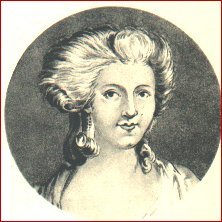 The trial, and the subsequent Memoirs of its chief feminine player, the Comtesse de la Motte, are credited by many historians with being the gust of foul wind which finally fanned the long-smouldering fire of popular discontent into the uncontrollable conflagration of the French Revolution.
The trial, and the subsequent Memoirs of its chief feminine player, the Comtesse de la Motte, are credited by many historians with being the gust of foul wind which finally fanned the long-smouldering fire of popular discontent into the uncontrollable conflagration of the French Revolution.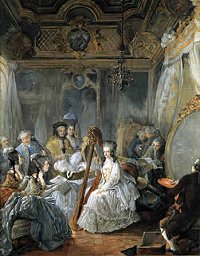 The tale is long, complex and sordid; it has several different versions (depending on whose memoirs you read), and has been told many times, most recently in a beautifully costumed Hollywood version starring Hilary Swank. The movie, which includes a stirring performance by Miss Swank as the Countess, takes some (but not all) of the Countess's claims at face value, which is another way of saying that it takes extreme liberties with what most historians regard as the actual truth.
The tale is long, complex and sordid; it has several different versions (depending on whose memoirs you read), and has been told many times, most recently in a beautifully costumed Hollywood version starring Hilary Swank. The movie, which includes a stirring performance by Miss Swank as the Countess, takes some (but not all) of the Countess's claims at face value, which is another way of saying that it takes extreme liberties with what most historians regard as the actual truth.Although she claimed to be descended from royalty, it is now generally agreed that Jeanne de Saint-Remy de Valois, Comtesse de la Motte, came of what might be termed "humble origins" and basically talked, schemed and slept herself almost all the way to the Royal Chambers at Versailles.
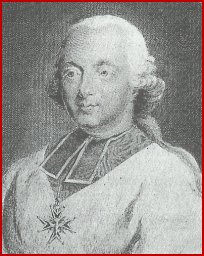 Jeanne carried on an affair with the Cardinal Louis Rene Edouard, Prince de Rohan, a man more attuned to matters earthly than spiritual. Jeanne also borrowed money from the Cardinal, and was soon deep in his debt. For his part the Cardinal was out of favor with Marie Antoinette, and was anxious to get into the Queen's good graces, if not her bed. Jeanne, who was undertaking her own campaign to gain access to the Queen and have her "family estates" "returned" to her, persuaded the Cardinal that she had the Queen's ear and could arrange reconciliation.
Jeanne carried on an affair with the Cardinal Louis Rene Edouard, Prince de Rohan, a man more attuned to matters earthly than spiritual. Jeanne also borrowed money from the Cardinal, and was soon deep in his debt. For his part the Cardinal was out of favor with Marie Antoinette, and was anxious to get into the Queen's good graces, if not her bed. Jeanne, who was undertaking her own campaign to gain access to the Queen and have her "family estates" "returned" to her, persuaded the Cardinal that she had the Queen's ear and could arrange reconciliation.The gullible and perhaps somewhat oversexed Cardinal agreed and the Countess arranged a correspondence between him and the Queen. His letters to Marie Antoinette were real enough, but never delivered; the Queen's return letters were forgeries produced by Jeanne herself, or possibly her husband, or perhaps her "secretary" and lover, the gallant former-cavalier Retaux de Vilette.
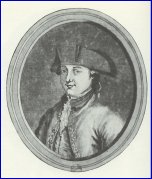
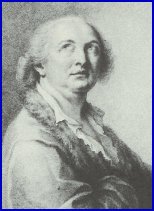 The famous and scandalous Count Cagliostro, alchemist, healer and all-round man-of mystery, had been befriended by the Cardinal, and the Cardinal relied on Cagliostro's direction and ability to see into the future to direct his dealings with the "Queen". Cagliostro, who was nobody's fool, went into trances and told the Cardinal that he saw the Cardinal being favored by the Queen and rising to a very high post in the government.
The famous and scandalous Count Cagliostro, alchemist, healer and all-round man-of mystery, had been befriended by the Cardinal, and the Cardinal relied on Cagliostro's direction and ability to see into the future to direct his dealings with the "Queen". Cagliostro, who was nobody's fool, went into trances and told the Cardinal that he saw the Cardinal being favored by the Queen and rising to a very high post in the government. The diabolical farce seemed to reach its climax with a midnight rendezvous in the Grove of Venus at the Palais-Royal Gardens, between the Cardinal and "Marie Antoinette" -actually an actress (or prostitute, or perhaps both, who could keep track at this point?) named Mademoiselle Leguay d'Olivia, who bore a remarkable resemblance to the Queen... and then the extravagant and fabulously costly diamond necklace entered the scene.
Ah, the necklace...
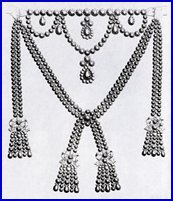 The Diamond Necklace had been made several years earlier "on speculation" by a firm of Parisian jewelers who had assumed they could sell it to Madame du Barry. When that did not work out they tried to interest Marie Antoinette in the necklace, and although she had been tempted, she considered it too extravagant and had refused to purchase it. Now the jewelers, teetering on the edge of bankruptcy because of the interest payments on the money they had borrowed to buy the stones, approached the Countess, who openly boasted about how close she was to the Queen, and asked her to persuade Antoinette to buy the overwrought bauble which was worth as much as a full-rigged warship.
The Diamond Necklace had been made several years earlier "on speculation" by a firm of Parisian jewelers who had assumed they could sell it to Madame du Barry. When that did not work out they tried to interest Marie Antoinette in the necklace, and although she had been tempted, she considered it too extravagant and had refused to purchase it. Now the jewelers, teetering on the edge of bankruptcy because of the interest payments on the money they had borrowed to buy the stones, approached the Countess, who openly boasted about how close she was to the Queen, and asked her to persuade Antoinette to buy the overwrought bauble which was worth as much as a full-rigged warship.Jeanne shrewdly took the matter to the Cardinal, who was very much inclined to negotiate a purchase he thought would endear him further to Marie. Once more the Cardinal consulted the Count Cagliostro, and once more Cagliostro went into a trance and foresaw the Cardinal enriched and rewarded by the Queen with a post at the highest rank of the government.
More outrageous lies, deception and forged letters ensued, and in the end the Queen agreed to purchase the necklace, or so the lovesick Cardinal and desperate jewellers were led to believe. The jewelers delivered the necklace to the Cardinal, and the Cardinal delivered it to a trusted servant of the Queen (or so it appeared) and then the necklace simply vanished!
Gee, bet you didn't see that coming, eh?
Next: Scandal, Trial, & Revolution!
